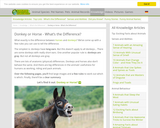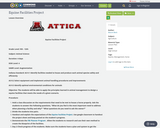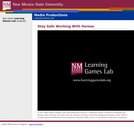
How to distinguish animals that look quite similar. Rules of thumb and helpful background information.
- Subject:
- Life Science
- Zoology
- Material Type:
- Reading
- Date Added:
- 01/03/2019

How to distinguish animals that look quite similar. Rules of thumb and helpful background information.

Equine Facilities Project Grade Level: 9th - 12thSubject: Animal ScienceDuration: 4 daysDOK Level: 4SAMR Level: AugmentationIndiana Standard: AS-9.1 Identify facilities needed to house and produce each animal species safely and efficiently AS-9.2 Select equipment and implement animal handling procedures and improvements AS-9.3 Identify optimal environmental conditions for animals Objective: The students will be able to apply the principles learned in animal management to design a equine facilities that meets the needs of a given scenario. Procedure: Hold a class discussion on the requirements that need to be met to house a horse properly. Ask the students to answer the Following questions, “What do you feel is the most important need to address when planning a facility and why?” “What questions do you need to ask the owner?” Divide the students into pairs.Handout and explain the expectations of the Equine Facilities Project. Use google classroom to handout the project sheet and keep posted on the student's progress.Demonstrate the FBI Planner Program . Allow the students to research and use their own method to create the blueprint of the facilities. Day 2 Check progress of the students. Make sure the students have a plan and system to get the project completeDay 3 Check the students’ written descriptions for the project. Make sure there are no misunderstandings to this pointDay 4 Have the students present their ideas to the rest of the class. Product or Assessment: The students product will consist of a blueprint of the facilities and a written description describing the blueprint with reasoning/justification to the decision that were made.

In this interactive, learners develop the skills to handle a horse safely before entering the corral for the first time. The interactive consists of three stages, each explaining an aspect of the safety procedures necessary for leading a horse.

This resource is a video abstract of a research paper created by Research Square on behalf of its authors. It provides a synopsis that's easy to understand, and can be used to introduce the topics it covers to students, researchers, and the general public. The video's transcript is also provided in full, with a portion provided below for preview:
"Synovitis is one of the most common and serious musculoskeletal diseases in horses, causing osteoarthritis and lameness. While available pharmaceutical treatments can reduce joint pain and inflammation, they are expensive and unable to prevent disease progression. Recently, researchers have started looking toward fibroblast-like synoviocytes (FLS) for the development of new treatment options. FLS are cells that produce lubricating proteins to protect cartilage from injury, But they lose their protective features and begin to produce inflammatory chemicals in horses with synovitis and ultimately cause the failure of the FLS mitochondrial machinery, cell death, and joint degeneration. A team of researchers thus transferred healthy mitochondria from immune cells into FLS to determine whether doing so could restore FLS function. They found decreases in cell proliferation and death after mitochondrial transfer as well as a reduction in the production of inflammatory proteins..."
The rest of the transcript, along with a link to the research itself, is available on the resource itself.

This resource is a video abstract of a research paper created by Research Square on behalf of its authors. It provides a synopsis that's easy to understand, and can be used to introduce the topics it covers to students, researchers, and the general public. The video's transcript is also provided in full, with a portion provided below for preview:
"Equine genetics reveals otherwise invisible traits linked to your horse’s appearance Several dilution genes—which lighten pigments in skin, eyes and hair—have been identified The SLC45A2 gene affects red and black pigments, creating cream and pearl coats But there are still gaps in the genetic story behind these coat colors Now, researchers have identified two new SLC45A2 variants One originated in medieval times and gives rise to the well-known pearl dilution The other—whose origin is unknown— produces a similar but entirely new dilution dubbed "sun" This research suggests that there’s much more to learn in equine genetics and the results can empower breeders and owners to provide the best care for their horses Holl et al. "A candidate gene approach identifies variants in SLC45A2 that explain dilute phenotypes, pearl and sunshine, in compound heterozygote horses." Anim Genet..."
The rest of the transcript, along with a link to the research itself, is available on the resource itself.